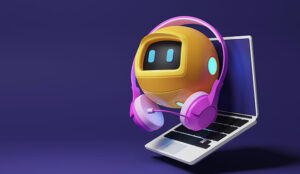Whitney Rose at Assembled explores how we got here – and why knowing the history of AI in support can help separate fact from fiction in today’s fast-moving landscape.
AI in customer support has evolved dramatically over the years, with each new wave promising to revolutionize the way teams engage with customers.
From early, scripted chatbots to today’s advanced AI copilots, support leaders have witnessed many phases of AI technology – some transformative, others fleeting.
But understanding the true potential of AI today requires a step back to see where it all began. The hype, the setbacks, and the gradual evolution have all shaped the AI we use in support today.
ELIZA, IVRs, and the Roots of AI in Support (1960s–1980s)
The idea of AI-powered support isn’t new. In fact, the first sparks of machine–human interaction go all the way back to the 1960s.
In 1966, MIT computer scientist Joseph Weizenbaum created ELIZA, a computer program designed to simulate human conversation.
ELIZA’s script mimicked a psychotherapist by reflecting questions back to the user (“How does that make you feel?”). The interactions were surface-level, but they introduced a powerful concept: that machines could talk.
Around the same time, early interactive voice response (IVR) systems were being developed. These allowed customers to navigate phone menus using touch-tone keypads instead of waiting for human agents – laying the foundation for automating routine support tasks.
While primitive by today’s standards, these early systems showed the first glimmers of how AI could one day support human conversations at scale.
Rules, NLP, and Early AI in Support (1990s–2000s)
As computing power grew in the 1990s and early 2000s, so did ambitions for AI in customer support. But rather than focusing on open-ended conversations, most early tools zeroed in on specific, rules-based tasks.
Basic chatbots emerged that could follow simple decision trees – “If customer says X, reply with Y.” These bots could answer FAQs or help route tickets, but their rigidity meant they often hit frustrating dead ends.
At the same time, natural language processing (NLP) started gaining traction. Early NLP models aimed to understand customer input, but intent detection was still in its infancy.
This marked a shift from pure automation to something slightly more intelligent – though still far from seamless.
Combined with the growing adoption of help desks and CRM systems, these early AI tools began carving out a place in the modern support workflow. They weren’t replacing agents, but they were starting to assist them.
Smarter Workflows and Data-Driven AI Features (2010s)
In the 2010s, AI in customer support quietly levelled up.
Thanks to cloud computing, support platforms became more scalable and data-rich, giving teams access to the historical data AI tools need to learn.
At the same time, advances in machine learning made it possible to move beyond fixed rules and train models based on real customer conversations.
Support orgs began using AI-powered features to:
The Generative Leap: LLMs Reshape Support (2020s)
The early 2020s marked a turning point. With the arrival of large language models (LLMs) like OpenAI’s GPT-3 and GPT-4, AI moved from behind-the-scenes tooling to centre stage.
Suddenly, machines could generate human-like responses, summarize long threads, translate languages, and handle complex queries – all in real time.
This shift from task-based automation to adaptive, conversational AI opened up entirely new possibilities for support teams.
Instead of just tagging tickets or suggesting help articles, generative AI could:
- Draft full replies based on context
- Automatically summarize conversations for follow-up
- Help agents respond faster across chat, email, and even voice
- Deliver always-on, multilingual support – often without the need for rigid scripts or heavy setup
It wasn’t just a technology shift – it was a mindset shift. Support orgs began exploring how AI could not only increase efficiency, but also improve consistency, personalization, and agent satisfaction.
Of course, it also raised new questions around accuracy, brand voice, privacy, and oversight. But one thing became clear: this wave of AI wasn’t just an upgrade. It was a rewrite.
How AI Is Transforming Support Right Now
Today, AI is woven into nearly every part of the support experience – not as a replacement for human agents, but as a force multiplier for speed, consistency, and scale.
Across teams and tools, AI is helping support orgs:
- Draft responses in chat, email, and even voice
- Summarize complex conversations in real time
- Classify and route tickets based on intent or urgency
- Assist agents live with suggestions, context, and relevant articles
- Power self-service tools that can handle nuanced, multi-turn queries
- Translate conversations across languages instantly
It’s no longer about bots vs. humans – it’s about building smart systems where AI and agents work together. And while there’s still plenty of experimentation ahead, AI is already delivering tangible results: faster replies, happier agents, and better customer outcomes.
The Future Is Connected: AI Agents Across Every Channel
The next frontier of AI in support isn’t just faster replies or smarter summaries – it’s orchestration across every channel, team, and customer touchpoint.
Support leaders are moving beyond one-off automations toward AI agents that resolve issues, escalate with context, and stay on-brand from start to finish. These aren’t just bots – they’re connected systems that adapt in real time and scale with your team.
This blog post has been re-published by kind permission of Assembled – View the Original Article
For more information about Assembled - visit the Assembled Website
Call Centre Helper is not responsible for the content of these guest blog posts. The opinions expressed in this article are those of the author, and do not necessarily reflect those of Call Centre Helper.
Author: Assembled
Reviewed by: Jo Robinson
Published On: 26th May 2025
Read more about - Guest Blogs, Assembled, Whitney Rose






 Assembled is a Support Operations platform that helps companies maintain exceptional customer experiences, no matter what lies ahead. Leading brands use Assembled's workforce and vendor management capabilities to make optimal staffing decisions, gain visibility into performance and productivity, and unlock new ways to serve evolving customer needs.
Assembled is a Support Operations platform that helps companies maintain exceptional customer experiences, no matter what lies ahead. Leading brands use Assembled's workforce and vendor management capabilities to make optimal staffing decisions, gain visibility into performance and productivity, and unlock new ways to serve evolving customer needs. 


































